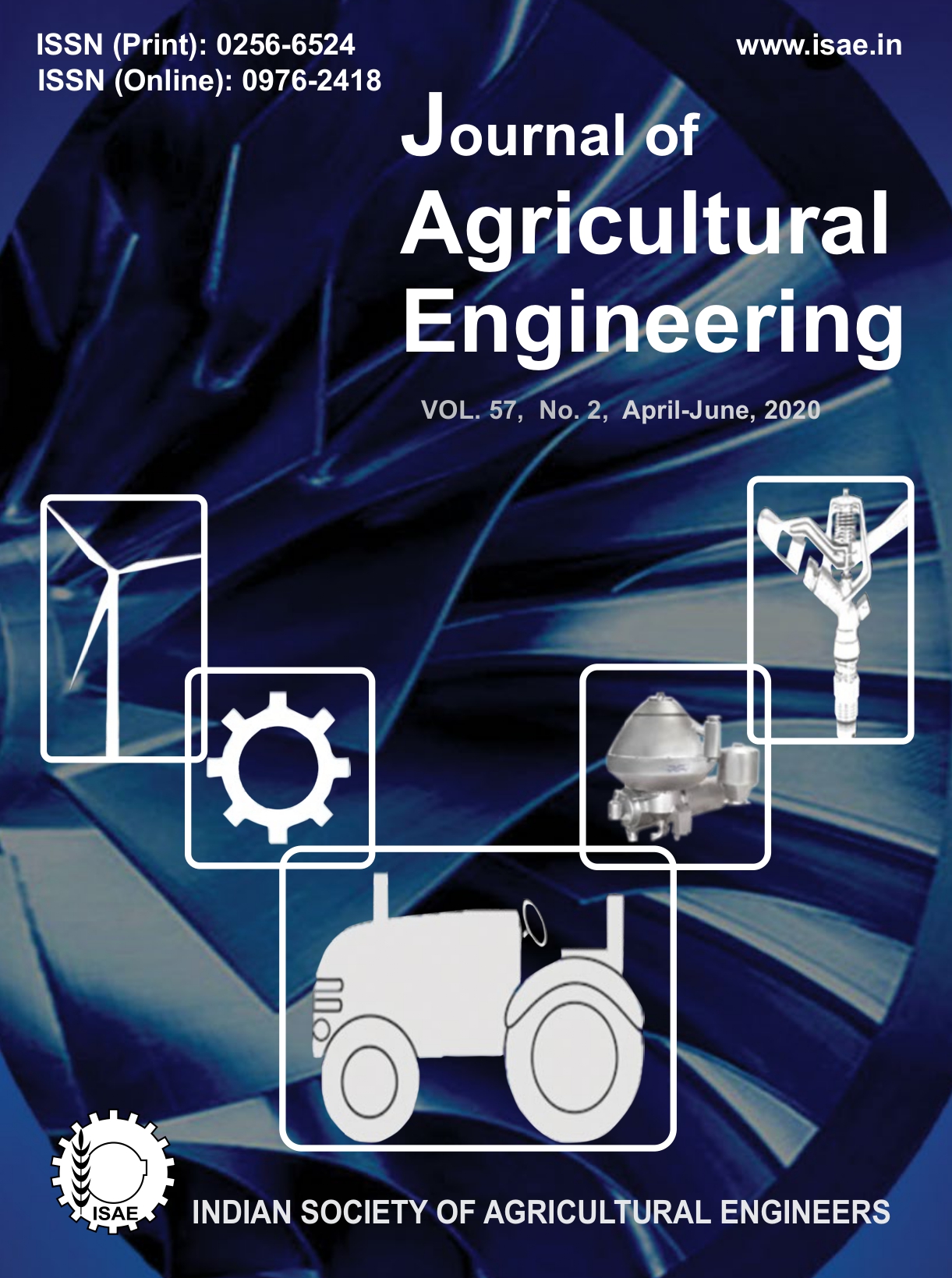Analysis of Rainfall Characteristics for Crop Planning in North and South Saurashtra Region of Gujarat
DOI:
https://doi.org/10.52151/jae2020572.1712Keywords:
Rainfall, onset, withdrawal, monsoon, Markov chain model, conditional probability, crop planningAbstract
Knowledge of the sequences of dry and wet spells as well as onset and withdrawal of monsoon season is necessary for successful planning and management of agricultural ecosystem. In this study, 21-year (1997-2017) rainfall data of the North and South Saurashtra region of Gujarat were analysed to understand and quantify the South-west monsoon characteristics. Analysis of the results revealed that the onset and withdrawal of rainy season occurred during the 26th Standard Meteorological Week (SMW) and 40th SMW, respectively, in the North and South Saurashtra region. The length of the rainy season was 15 weeks for South Saurashtra and 14.5 weeks for North Saurashtra region. The South - and North-Saurashtra region received 96.7 % and 95.1 % of the mean annual rainfall, respectively, during the monsoon season. The initial probability of the wet weeks (25th - 34th SMW) and the conditional probability of wet week, followed by another wet week in the Saurashtra region varied from 47.6 % to 66.7 %, and 20.0 % to 64.3 %, respectively. Results indicated that the land preparation and sowing of kharif crops should be undertaken during the 24th to 26th SMW. The sowing of dryland crops in rabi season may be completed between 40th and 41st SMW, as remaining weeks have less probability of getting sufficient rainfall.
References
Dabral P P; Purkayastha K; Aram M. 2014.Dry and wet spell probability by Markov chain model-A case study of north Lakhimpur (Assam), India. Int. J. Agric. Biol. Eng., 7(6), 8-13.
Dave H; James M E. 2017. Characteristics of intense rainfall over Gujarat State (India) based on percentile criteria. Hydro. Sci. J., 62(12), 2035-2048.
Deora B S; Singh R V. 2008.Frequency analysis of water deficit for crop planning in Gujarat. J. Agrometrol., 10(2), 184-187.
Jat M L; Singh R V; Balyan K; Jain L K. 2005. Rainfall analysis for crop planning in Udaipur region. Indian J. Soil Conserv., 33(3), 264-266.
Khan S; Hanjra M A. 2009. Footprints of water and energy inputs in food production- Global perspectives. Food Policy, 34, 130-140.
Mandal K G; Padhi J; Kumar A. 2015. Analyses of rainfall using probability distribution and Markov chain models for crop planning in Daspalla region in Odisha. Indian Theor. Appl. Climatol., 121, 517–528.
Nandargi S S; Kumar A; Warwade P. 2019. analysis of rainfall land rainstorms over the Gujarat State, India. J. Res. Eng. Appl. Sci., 4 (1), 43-56.
Patel P M; Saha D; Shah T. 2020. Sustainability of groundwater through community-driven distributed recharge: An analysis of arguments for water scarce regions of semi-arid India. J. Hydrol. Reg. Stud., 29,100680, 1-16.
Priyan K. 2015. Spatial and temporal variability of rainfall in Anand district of Gujarat State. Aquatic Procedia, 4, 713-720.
Rai S; Singh K A. 2010. Onset, end and duration of rainy season in two districts of North Bihar. J. Agrometrol., 12 (2), 248-250.
Rai S K; Kumar S; Rai A K; Satyapriya; Palsaniya D R. 2014. Climate change, variability and rainfall probability for crop planning in few districts of central India. Atmos. Clim. Scenarios, 4, 394-403.
Sharma B R; Rao K V; Vittal K P R; Ramakrishna Y S; Amarasinghe U. 2010. Estimating the potential of rainfed agriculture in India: Prospects of water productivity improvements. Agric. Water Manage., 97(1), 23-30.
Sharma C; Singh M; Sharma R; Sharma V. 2017. Analysis of rainfall characteristics for crop planning under low altitude sub-tropical agro-ecological zone of Jammu region. J. Agrometrol., 19, 60-66.
Sikka A K; Islam A; Rao K V. 2018. Climate‐smart land and water management for sustainable agriculture. Irrig. Drain., 67(1), 72-81.
Singh Jai Vir. 2010. Water Requirement of Different Crops. Agropedia, posted on 27.1.2010. http:// agropedia.iitk.ac.in/content/water-requirement-different-crops
Singh G; Singh R M; Chandola V K; Nema A K. 2019. Rainfall analysis for crop planning under rainfed condition at Mirzapur district in Vindhya plateau of Indo-Gangetic Plain. Indian J. Soil Conserv., 47(1), 30-36.
Subash N; Singh S S; Neha P. 2012. Rainfall variability and its impact on change of cropping systems in Bihar. Indian J. Soil Consver., 40, 33-40.
Swetha A N; Srinivasareddy G V; Krishnamurthy D; Babu B M; Nemichandrappa M. 2015. Characterization of rainfall, weekly dry and wet spells and probability analysis of rainfall at Hatti, Karnataka. Karnataka. J. Agric. Sci., 28(5), 741-745.
Vaidya V B; Karande B I; Pandey V; Lunagaria M M; Shekh A M. 2008. Rainfall probability analysis for crop planning in Gujarat state. J. Agrometeorol., 10(1- 2), 183-185.














